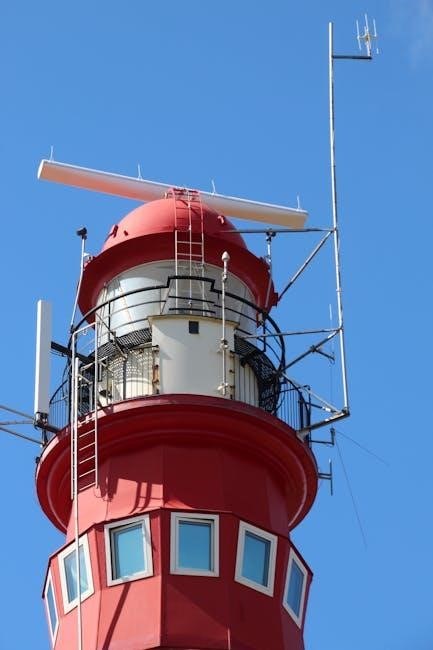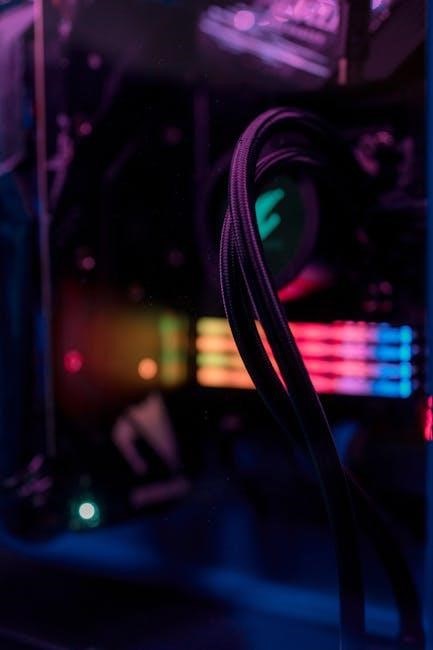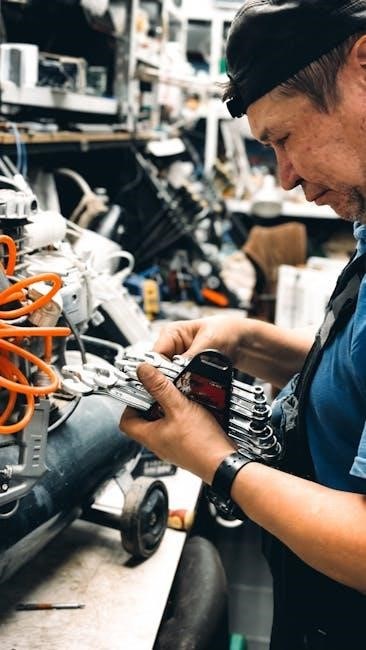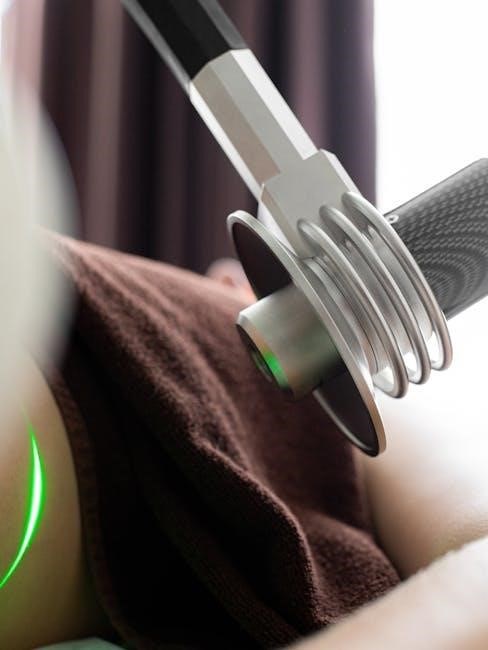Understanding Trailer Wiring Basics
Trailer wiring enables communication between your vehicle and trailer‚ ensuring proper lighting and safety. It involves connectors‚ wiring harnesses‚ and lights‚ with color-coded wires for functionality.
1.1 Purpose and Importance of Proper Trailer Wiring
Proper trailer wiring ensures safe communication between your vehicle and trailer‚ powering lights‚ brakes‚ and auxiliary systems. Correct connections prevent accidents‚ legal issues‚ and damage to electrical components. It guarantees all lights‚ including brake and turn signals‚ function correctly; Improper wiring can lead to hazards‚ so understanding and maintaining it is crucial for safety and reliability while towing.
1.2 Basic Components of a Trailer Wiring System
A trailer wiring system includes a trailer connector‚ wiring harness‚ lights‚ and connectors. The connector links your vehicle to the trailer‚ while the harness distributes power to lights and brakes. Lights include tail‚ brake‚ and turn signals. Connectors ensure secure‚ corrosion-resistant links. Proper installation and maintenance of these components ensure reliable operation‚ safety‚ and compliance with regulations while towing.

Types of Trailer Connectors
Trailer connectors vary in pin configurations‚ with 4-pin and 7-pin being the most common. The 4-pin is ideal for basic lighting‚ while the 7-pin supports brakes and auxiliary power.
2.1 4-Pin Trailer Connector
The 4-pin trailer connector is simple and widely used for basic setups. It supports tail lights‚ brake lights‚ and turn signals. Each wire has a specific function: green for right turn/brake‚ yellow for left turn/brake‚ brown for tail lights‚ and white for ground. This connector is ideal for small trailers like boats or ATVs‚ ensuring essential lighting functions without extra features. It’s easy to install and reliable for everyday use.
2.2 7-Pin Trailer Connector
The 7-pin trailer connector is versatile‚ supporting more functions than the 4-pin. It includes connections for brakes‚ auxiliary power‚ and reverse lights. Each pin is color-coded: blue for brakes‚ black for 12V power‚ and purple for reverse lights. This connector is ideal for larger trailers with advanced features like electric brakes. While more complex‚ it offers better performance and safety for heavy-duty towing needs‚ ensuring all systems operate smoothly.
2.3 Other Connector Types (6-Pin‚ Round‚ etc.)
Beyond the 4-pin and 7-pin‚ other connectors cater to specialized needs. The 6-pin connector adds an auxiliary circuit‚ often for retractable trailers. Round connectors are common in Europe and offer a sealed design for durability. Each type has specific uses‚ ensuring compatibility and functionality. Adapters are available to bridge different connector styles‚ making it easier to tow various trailers with a single vehicle setup‚ enhancing convenience and versatility for different towing scenarios and requirements.

Choosing the Right Wiring Materials
Selecting the right materials ensures reliability and safety. Proper wire gauge prevents overheating‚ while weather-resistant insulation protects against elements. High-quality connectors minimize corrosion and signal loss‚ ensuring optimal performance and longevity.

3.1 Selecting the Correct Gauge Wire
Choosing the right wire gauge is crucial for your trailer’s electrical system. A lower gauge number indicates thicker wire‚ suitable for higher current demands. For most trailers‚ 14- to 16-gauge wires suffice. However‚ heavier trailers or those with additional lighting may require 10- or 12-gauge wires. Always consult your vehicle’s specifications and the trailer’s requirements to ensure safe and efficient power distribution. Proper gauge selection prevents overheating and ensures reliable performance.
3.2 Trailer Wiring Harness: What You Need to Know
A trailer wiring harness simplifies connecting your vehicle to the trailer‚ ensuring all lights and brakes function properly. It typically includes pre-wired connectors‚ protective insulation‚ and plug-and-play adapters. The harness shields wires from environmental damage and reduces the risk of short circuits. When selecting a harness‚ ensure compatibility with your vehicle’s electrical system and the trailer’s requirements for reliable performance and safety. Proper installation is key to avoiding electrical issues and ensuring long-term durability.
3.3 Connectors and Adapters: Key Considerations
Connectors and adapters are crucial for ensuring a safe and reliable connection between your vehicle and trailer. Choose connectors that match your trailer’s wiring system‚ such as 4-pin or 7-pin types. Adapters can bridge compatibility gaps between different connector styles. Always opt for weatherproof options to protect against moisture and corrosion. Properly securing connectors and regularly inspecting them can prevent electrical issues. Using the right adapter ensures seamless communication between systems‚ avoiding potential hazards. Invest in high-quality connectors for long-term reliability and safety.

Trailer Wiring Installation
Connectors and adapters ensure compatibility between your vehicle and trailer. Choose weatherproof options to prevent corrosion and moisture damage. Adapters bridge wiring system differences‚ like 4-pin to 7-pin conversions. Regularly inspect and clean connectors to maintain electrical integrity. Secure connections firmly to avoid loose wires. High-quality adapters and connectors prevent signal loss and ensure reliable communication between systems‚ enhancing safety and performance while towing. Always match connectors to your trailer’s specific wiring configuration for optimal functionality.
4.1 Step-by-Step Guide to Connecting Trailer Connectors

Connecting trailer connectors involves matching wire colors to ensure proper functionality. Start by identifying the connector type (4-pin‚ 7-pin‚ etc.) and prepare the wiring harness. Use a circuit tester to verify connections. Attach the wires to the corresponding pins‚ following a color-coded diagram. Secure connections with heat-shrink tubing or solder. Test each circuit (brakes‚ lights‚ etc.) to ensure they function correctly. Finally‚ inspect the connector for any loose wires or damage before towing. Proper installation ensures safety and reliability on the road.
4.2 Installing a Trailer Wiring Harness
Installing a trailer wiring harness involves mounting the control box near the tow vehicle’s electrical system. Connect the harness to the vehicle’s battery and wiring‚ ensuring proper grounding. Route the wires to the trailer‚ securing them with clips or ties. Attach the trailer connector and install any necessary components like brake controllers. Use a circuit tester to verify connections. Heat-shrink tubing can protect wire splices. Regularly inspect the harness for damage or corrosion to maintain reliability and safety while towing.

Testing Your Trailer Wiring
Test your trailer wiring by using a circuit tester to verify all connections. Ensure brake lights‚ tail lights‚ and turn signals function correctly before towing.
5.1 Using a Circuit Tester for Diagnosis
A circuit tester is essential for diagnosing trailer wiring issues. It helps identify faulty connections and verifies the functionality of each wire. Use the tester to check the ground connection‚ brake lights‚ and turn signals. This tool ensures all components are working correctly before towing. By pinpointing electrical problems quickly‚ it saves time and prevents potential safety hazards on the road.
5.2 Checking Brake and Tail Lights
To ensure your trailer’s brake and tail lights function correctly‚ start by consulting a wiring diagram specific to your connector type. Use a circuit tester to verify power to the appropriate wires when the brakes or lights are activated. Check for a secure ground connection‚ as a faulty ground can prevent lights from working. Inspect wires and connectors for damage or corrosion‚ cleaning or replacing them as needed. If issues persist‚ consider checking the vehicle’s fuse box for blown fuses related to the trailer lighting system. This systematic approach helps identify and resolve issues efficiently.

Troubleshooting Common Issues
Identify issues by using a circuit tester to locate faulty connections or corrosion. Check all wires and connectors for damage‚ ensuring a proper ground for reliable operation.
6.1 Identifying and Fixing Faulty Connections
Use a circuit tester to identify faulty connections‚ checking for power at each connector. Inspect wires for corrosion or damage‚ ensuring all terminals are secure. Replace any damaged components and clean connections. Verify the ground wire is properly attached to ensure reliable signal flow. Loose or corroded connectors can cause lighting issues‚ so tighten all connections and apply dielectric grease for protection.
6.2 Common Wiring Problems and Solutions
Common issues include blown fuses‚ faulty grounds‚ and incorrect wire connections. Check fuses first if lights fail. Ensure the ground wire is securely attached to the trailer frame. Use a wiring diagram to verify connections and replace damaged wires. Apply dielectric grease to connectors to prevent corrosion. For intermittent issues‚ inspect wiring for chafing or pinched areas and repair or replace as needed to ensure reliable trailer performance.

Safety Tips for Trailer Wiring
Protect wiring from damage by routing it securely. Regularly inspect connectors for corrosion and wear. Use dielectric grease to prevent rust. Test lights before towing for safety.
7.1 Protecting Your Trailer Wiring from Damage
Shield your trailer wiring from environmental stress by securing it with clips or ties. Avoid pinching wires during installation. Use durable‚ weather-resistant connectors to prevent corrosion. Insulate exposed wires to reduce wear. Regularly inspect for frays or cuts. Apply dielectric grease to connectors to repel moisture. Keep wiring away from hot surfaces and moving parts to ensure long-term reliability and safety while towing.
7.2 Regular Maintenance for Optimal Performance
Regularly inspect all trailer wiring connections and wires for damage or wear. Use a circuit tester to verify functionality. Clean corroded connectors and apply dielectric grease for protection. Check for loose wires and secure them properly. Inspect the wiring harness for signs of chafing or fraying. Schedule annual checks to ensure all components are in good condition. This routine maintenance ensures reliable operation and enhances safety while towing.

Advanced Trailer Wiring Configurations
Advanced trailer wiring configurations enhance functionality and safety for specialized setups. This includes brake controllers‚ custom wiring solutions‚ and auxiliary power systems for improved performance and reliability.
8.1 Adding a Brake Controller
A brake controller is essential for regulating electric brakes on trailers. Installation involves connecting it to the brake wire and vehicle’s power supply. Proper setup ensures synchronized braking‚ enhancing safety. Use a circuit tester to verify connections and functionality. Regular maintenance and adjustment are crucial for optimal performance. This configuration is vital for trailers with electric brakes‚ ensuring smooth and controlled stopping.
8.2 Custom Wiring Solutions for Specialized Trailers
Custom wiring solutions are tailored for specialized trailers with unique electrical needs. These setups may include additional circuits for features like winches‚ interior lights‚ or refrigeration units. Consulting detailed wiring diagrams is essential to ensure all components are correctly connected. Proper installation requires careful planning and testing to avoid electrical issues. For complex configurations‚ professional assistance is recommended to guarantee safety and reliability.



